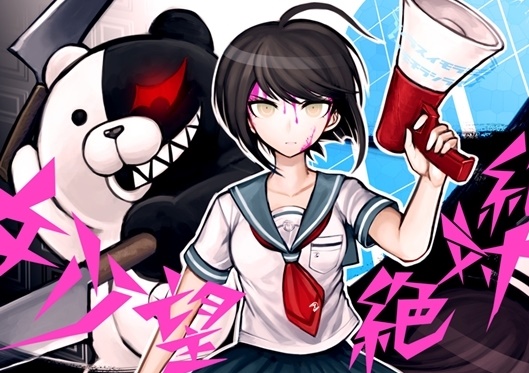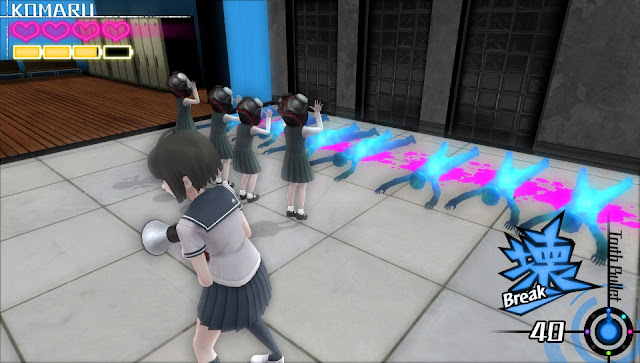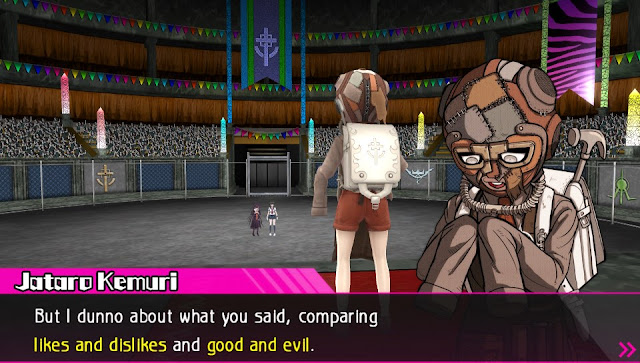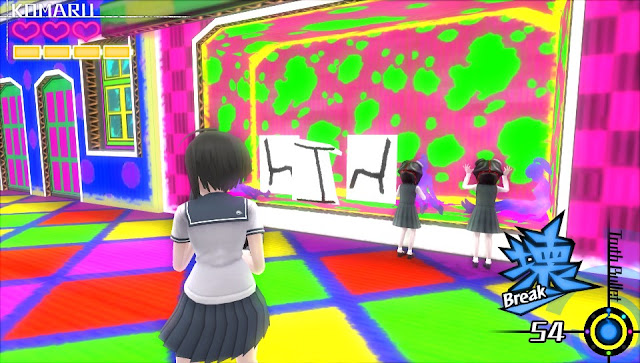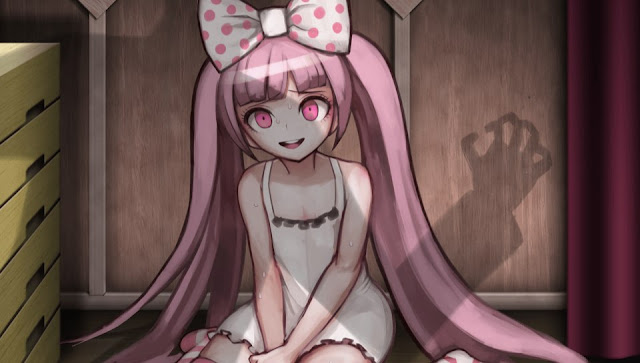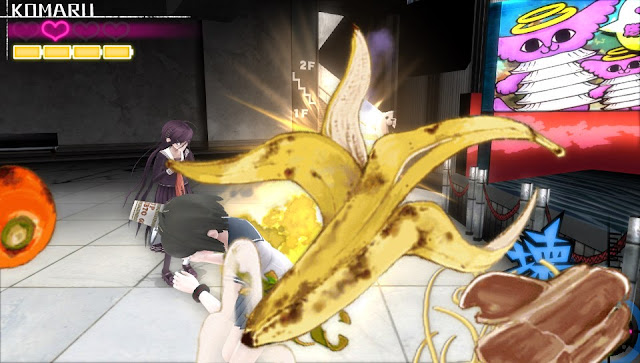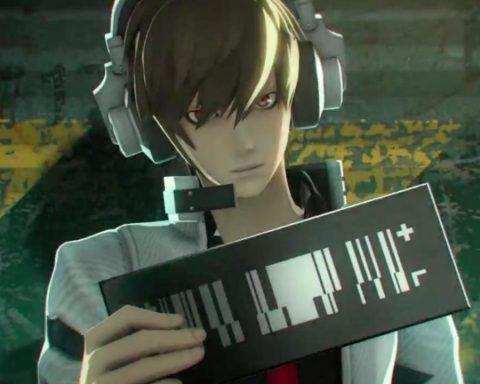Danganronpa Another Episode: Ultra Despair Girls is a deeply unsettling game. And I mean that as a genuine compliment. I don’t think there has been another game that has managed to shake me quite as profoundly as this one.
But at first I absolutely hated the thing. After handing out 5/5 scores to both Danganronpa and its sequel, I had been wary about this one from the point that it was first announced. Where Danganronpa and its sequel were tight, tense visual novels, more interested in telling a story than challenging a player’s more traditional gaming skills, I thought the pivot that Ultra Despair Girls was taking to turn the series to a more action-based shooter might have been a misfire.
Related reading: And Matt’s review of Danganronpa 2 for your reading pleasure.
And at first it was confirming every one of my fears. Over the course of the first chapter enemies displayed terrible AI, the shooting mechanics are too simple to be engaging, and the gorgeous, restricted and highly detailed environments and 2D static images representing characters in the first two Danganronpa games had been replaced with a large 3D world and characters that looked like PlayStation One games, albeit cleaner and with better animation.
Surprisingly little of worth happens across the first half dozen hours of that opening act. You’re introduced to the two main characters: Komaru Naegi, the little sister of the first game’s protagonist, and Toko Fukawa, AKA Genocidal Jill, the split personality character that was surely the most narratively limited and least likable of all characters across both games. Naegi is given a specialised gun that won’t hurt people, but can destroy robots (with almost all enemies being various iterations of the robotic bear, Monokuma). This gun proves to be effective at taking down small groups of Monokumas, but she is too much of a glass cannon to handle groups larger than three. When the swarms turn up it’s time call on Fukawa to turn into Genocidal Jill. She is immune to damage in her psychotic form and takes groups of Monokumas down with ease. Unfortunately, she’s also only able to maintain this form for a very short period of time, so players need to use her power like it’s a scarce resource.
It’s a system that works (in the sense that it’s possible to progress through the game with it), but it’s both archaic and too simple for its own good, and compounding this uninspiring introduction to the game that I experienced were the enemy Monokumas which, while visually as intimidating as ever, displayed the worst pathfinding and AI I have seen in many, many years. The only break to this structure were periodic puzzle rooms, where Naegi and Fukawa are tasked with pulling off trick shots and killing all the Monokumas in a room with a single shot. These were indeed different, but the solutions to them were always far too simple and straightforward, so in the early going I wasn’t having a great time with them either.
But a far, far bigger problem in the early stages is how completely uninteresting the narrative is. After being introduced to the two heroes, they spend the first half dozen hours literally getting to know one another and trying to figure out a way to escape a city that has been overrun by murderous children (out to hunt the adults to extinction) and Monokumas, seemingly being controlled by the kids. In this time we’re also only given the briefest of introductions to a group of kids that appear to be the leaders of the group and who have modelled themselves as RPG-like heroes. Beyond that, we read a couple of notes left around the environment that show the adults are quite frightened, and we witness one death that makes it quite clear that there will be no escape from this city for Naegi and Fukawa.
It does the job of setting up what is to come afterwards, but coming from the instant narrative highs of the first two Danganronpa games, the fact that Ultra Despair Girls uses its first chapter to behave like a Resident Evil fanfiction almost had me give up on the game there and then. Thankfully as a critic I had to push through that initial disappointment, because from the point of the first boss battle onwards, this game’s narrative becomes shockingly affecting and breathtakingly intense.
The first two Danganronpa games were largely focused on exploring the philosophy and psychology that drives game theory, and specifically how that economic theory demonstrates neatly how people tend to think and behave in all situations of stress and competition. Those two original games were figuratively insular and introverted, set as they were in small spaces, and this was also reflected in the way the narrative itself was so focused on what was going on in the brains of the individuals, rather than making some kind of grand point about broader society.
But Ultra Despair Girls is a very different beast. Set in a full city as it is, the narrative is also focused on making a far more grand point. What people will draw out of the narrative will vary from person to person, but the one I would like to address in this review as the one that affected me to the greatest degree was the way the game expressed a relativist approach to morality, challenging players on the assumption that they are, in fact, on the side of heroism. To make such a statement sounds ridiculous, given that the children are participating in a truly horrific act in massacring the adults of the city (and the streets are littered with bodies that the children are playing with to really drive that point home), but the narrative does something quite fascinating in also making it explicit that the actions of the adults were directly responsible for the children’s murderous tendencies.
The five ringleaders of the children, representing and acting as a voice for all the children in Ultra Despair Girls, have each been through an extreme level of psychological and physical abuse at the hands of their parents, and this has directly shaped their personalities. One boy is overwhelmed by self-loathing and a need to have everyone around him hate him. Why? Because he was too handsome, and his mother forced him to wear a mask at all times. Even more affecting is a young girl who was a singer and young idol. Our first real introduction to her was a memory flashback where we see her half-undressed and cowering in a corner while her father promises to be “gentle” with her. This girl now dresses as a lolita and is quick with the pedophile jokes, but suddenly her desire to murder adults suddenly has a very real context.
The way the game explores its themes is unflinching and uncomfortable; it holds back nothing, but it was necessary to do that in order for it to build in the players an odd sense of sympathy for the children. The only way the narrative was going to be able to convince players that there is a genuine belief among the children that that only path to true peace would be to get rid of the adults is by showing the very worst that adults can do to children. This idea is further reinforced by the fact that each of these ringleader children controls a giant robot, and these become the game’s bosses, playing out almost like a human vs. Transformer or Power Ranger battle. As brutal as the actions of the kids are, it is these boss battles that show that ultimately everything done by them is done in the naivety and misguided well meaning that characterises the behaviour of many children.
Further compounding this theme is the way the game presents the surviving adults. Almost universally these adults are quivering blobs, terrified, in hiding, and providing no meaningful attempt at resistance to the armies of children and Monokuma. The narrative wants us to interpret this as weakness, and hold the adults in contempt for it. Rather than having defined forms, faces, and personalities, the adults of Ultra Despair Girls are monochrome blue, red and pink blobs with no characteristic features or names, and so undefined as they are, we are not meant to connect with them. Rather, we are meant to sympathise more with the children as victims, even as we are trying to help Naegi and Fukawa survive their aggression.
This debate between the natures of good and evil has always been the kind of broader political narrative that the Danganronpa series has hinted at, but as our first look outside the prisons of the first two games, this is the first time we’ve had a good sense of the broader context of what is going on. This is a long game, and there are all kinds of twists and turns that happen towards its conclusion, but I won’t spoil any of that here. Suffice to say that the implications of some of its themes are suitably shattering and mind-bending, and for anyone interested in moral philosophy, Ultra Despair Girls is the kind of art work that you’ll be able to build a PhD on.
It’s not a perfect narrative, mind. As with each Danganronpa game to date, the developer really struggles to finish the narrative off convincingly. While the concluding act isn’t enough to destroy the quality of the rest of the story, Ultra Despair Girls is overlong in the end, and much of it unnecessary and superfluous to the core message that it wants to get across. I can appreciate that games this philosophically dense can be difficult for the story writers to the provide a convincing closure to the players, but it would have been nice if the writers at least tried to provide an answer to the questions they raise through the story.
On the plus side, the gameplay itself actually improves the further into the game it goes. Naegi starts to pick up alternative “bullets” for her gun, which each have different effects, such as zapping enemies in water, causing others to start dancing on the spot (attracting all other enemies into a small area and making them vulnerable to explosive weapons) and so on. These bullets need to be used to overcome some increasingly difficult puzzles. The core shooting never quite manages to be satisfying, but the journey between the narrative sequences eventually becomes a reward in its own right because the quality of the puzzles does improve markedly.
It’s also worth mentioning for all the horror that it throws the player’s way, and the environments that are a genuine vision of hell, Another Episode also has a wicked and biting sense of humour. It regularly breaks with the fourth wall, loves its sarcasm, and isn’t above going places with its jokes that would make Seth MacFarlane blush. This humour makes the horror elements have greater impact, ironically enough, by providing relief in between those moments of shock, disgust, and horrrific awe.
Danganronpa Another Episode ends up being an experiment that works, in taking the original games and doing something so completely different to them. It lacks the jump scares, monsters, and a significant difficulty level of the horror franchises that it aspires to be a part of, but is so unsettling is its narrative and vision that it is one of the most genuine, affecting horror games I have ever played. If the Night of the Living Dead of games is Resident Evil, and if Until Dawn is the interactive Halloween or Friday the 13th, then Ultra Despair Girls is our interactive take on The Exorcist or The Shining. It’s the thinking person’s horror experience, and despite a false start, it is absolutely brilliant.
– Matt S.
Editor-in-Chief
Find me on Twitter: @digitallydownld

